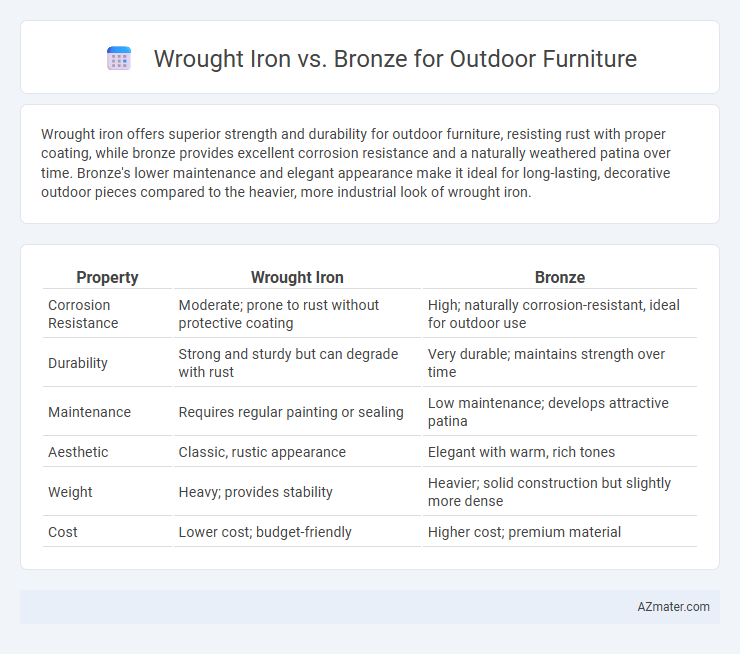Wrought iron offers superior strength and durability for outdoor furniture, resisting rust with proper coating, while bronze provides excellent corrosion resistance and a naturally weathered patina over time. Bronze's lower maintenance and elegant appearance make it ideal for long-lasting, decorative outdoor pieces compared to the heavier, more industrial look of wrought iron.
Table of Comparison
| Property | Wrought Iron | Bronze |
|---|---|---|
| Corrosion Resistance | Moderate; prone to rust without protective coating | High; naturally corrosion-resistant, ideal for outdoor use |
| Durability | Strong and sturdy but can degrade with rust | Very durable; maintains strength over time |
| Maintenance | Requires regular painting or sealing | Low maintenance; develops attractive patina |
| Aesthetic | Classic, rustic appearance | Elegant with warm, rich tones |
| Weight | Heavy; provides stability | Heavier; solid construction but slightly more dense |
| Cost | Lower cost; budget-friendly | Higher cost; premium material |
Introduction to Outdoor Furniture Materials
Wrought iron and bronze are popular materials for outdoor furniture due to their durability and aesthetic appeal. Wrought iron offers strength and classic ornamental designs but requires regular maintenance to prevent rust, while bronze provides corrosion resistance and develops a desirable patina over time, enhancing its visual character. Both materials withstand outdoor conditions well, making them ideal choices depending on the desired style and maintenance level.
Overview of Wrought Iron
Wrought iron, known for its durability and classic aesthetic, is a popular choice for outdoor furniture due to its resistance to outdoor elements and ability to withstand heavy use. Its malleability allows for intricate designs and ornamental details, making it favored in traditional and vintage-style garden settings. Compared to bronze, wrought iron requires regular maintenance to prevent rust but offers greater structural strength and affordability.
Overview of Bronze
Bronze, an alloy primarily composed of copper and tin, offers exceptional durability and corrosion resistance, making it ideal for outdoor furniture exposed to varying weather conditions. Its natural patina develops over time, providing a unique, aesthetically pleasing finish that enhances outdoor spaces. Compared to wrought iron, bronze requires less maintenance due to its resistance to rust and environmental wear.
Durability: Wrought Iron vs Bronze
Wrought iron offers exceptional strength and resistance to heavy wear, making it highly durable for outdoor furniture, but it requires regular maintenance to prevent rust. Bronze provides superior corrosion resistance and develops a protective patina over time, enhancing its durability with minimal upkeep. Both metals withstand outdoor conditions well, but bronze's natural weatherproof qualities give it an edge in long-term durability.
Weather Resistance and Maintenance
Wrought iron outdoor furniture offers exceptional durability and high resistance to weather elements, especially when coated with rust-resistant paint, but requires periodic maintenance to prevent corrosion and maintain its appearance. Bronze furniture naturally withstands harsh weather conditions due to its corrosion-resistant properties and develops a desirable patina over time, which protects the metal beneath from further damage. While wrought iron demands regular upkeep including repainting and rust removal, bronze requires minimal maintenance, making it ideal for long-term outdoor use with less effort.
Design and Aesthetic Appeal
Wrought iron offers classic, intricate designs with a timeless, rustic aesthetic that enhances traditional and vintage outdoor spaces, while bronze provides a sleek, polished appearance with a warm, rich patina that evolves beautifully over time. Bronze's ability to develop a natural greenish patina adds character and unique charm, making it a favored choice for artistic and sculptural furniture pieces. Both materials lend themselves to durable, elegant outdoor furniture, but wrought iron's heavier, more ornate structure contrasts with bronze's smoother, more contemporary design versatility.
Weight and Mobility Considerations
Wrought iron outdoor furniture is significantly heavier, providing stability and resistance to strong winds but limiting mobility for frequent rearrangement. Bronze furniture, while still durable, tends to be lighter than wrought iron, enabling easier repositioning and transport without compromising strength. Choosing between the two depends on balancing the need for sturdiness with the convenience of mobility in your outdoor space.
Cost Comparison
Wrought iron outdoor furniture typically costs less upfront compared to bronze, with prices averaging around $150 to $500 per piece based on size and design complexity. Bronze furniture demands higher investment, often ranging from $400 to $1,200 or more, due to its material expense and intricate casting process. While wrought iron offers cost-effective durability, bronze provides superior corrosion resistance, justifying its premium price for long-term outdoor use.
Environmental Impact and Sustainability
Wrought iron offers high durability and is fully recyclable, reducing long-term environmental waste, but its production involves high energy consumption and carbon emissions due to iron ore mining and smelting processes. Bronze, an alloy of copper and tin, also boasts excellent recyclability and corrosion resistance, extending the lifespan of outdoor furniture with minimal maintenance, though copper mining carries significant ecological consequences such as habitat destruction and water pollution. Choosing between wrought iron and bronze should consider the lifecycle environmental impact, including raw material extraction, manufacturing energy use, and product longevity for sustainable outdoor furniture solutions.
Which is Best: Choosing for Your Outdoor Space
Wrought iron offers exceptional durability and classic aesthetic appeal, making it ideal for outdoor furniture that withstands harsh weather and heavy use. Bronze, while often more expensive, provides superior resistance to corrosion and develops a unique patina over time, enhancing its visual charm and longevity. Choosing between wrought iron and bronze depends on budget considerations, desired maintenance levels, and the specific environmental conditions of your outdoor space.

Infographic: Wrought iron vs Bronze for Outdoor furniture
 azmater.com
azmater.com